Relationships between Humor Styles and the Big Five Personality Traits in Workers: A Network Analysis
Abstract
1. Introduction
1.1. Literature Review
1.2. Aims of the Study
2. Methods
2.1. Participants
2.2. Humor Styles Questionnaire
2.3. Big Five Questionnaire
2.4. Statistical Analysis
3. Results
4. Discussion
5. Conclusions
Author Contributions
Funding
Institutional Review Board Statement
Informed Consent Statement
Data Availability Statement
Conflicts of Interest
References
- Blustein, D.L.; Kenny, M.E.; Di Fabio, A.; Guichard, J. Expanding the Impact of the Psychology of Working: Engaging Psychology in the Struggle for Decent Work and Human Rights. J. Career Assess. 2019, 27, 3–28. [Google Scholar] [CrossRef]
- Cartwright, S.; Cooper, C.L. Towards organizational health: Stress, positive organizational behavior, and employee well-being. In Bridging Occupational, Organizational and Public Health: A Transdisciplinary Approach; Bauer, G.F., Hämmig, O., Eds.; Springer: Dordrech, Germany, 2014; pp. 29–42. [Google Scholar]
- Peiró, J.M.; Tetrick, L. Occupational health psychology. In IAAP Handbook of Applied Psychology; Martin, P.R., Cheung, F.M., Knowles, M.C., Kyrios, M., Littlefield, L., Overmier, J.B., Prieto, J.M., Eds.; Wiley Blackwell: Hoboken, NJ, USA, 2011; pp. 292–315. [Google Scholar]
- Johnson, S.; Robertson, I.; Cooper, C.L. Well-Being: Productivity and Happiness at Work, 2nd ed.; Palgrave Macmillan Ltd.: London, UK, 2018. [Google Scholar]
- Di Fabio, A.; Saklofske, D.H. Positive Relational Management for Sustainable Development: Beyond Personality Traits—The Contribution of Emotional Intelligence. Sustainability 2019, 11, 330. [Google Scholar] [CrossRef]
- Di Fabio, A.; Saklofske, D.H. The Contributions of Personality Traits and Emotional Intelligence to Intrapreneurial Self-Capital: Key Resources for Sustainability and Sustainable Development. Sustainability 2019, 11, 1240. [Google Scholar] [CrossRef]
- Di Fabio, A.; Saklofske, D.H. The contributions of personality and emotional intelligence to resiliency. Pers. Individ. Differ. 2018, 123, 140–144. [Google Scholar] [CrossRef]
- Di Fabio, A.; Saklofske, D.H. The relationship of compassion and self-compassion with personality and emotional intelligence. Pers. Individ. Differ. 2021, 169, 110109. [Google Scholar] [CrossRef] [PubMed]
- Di Fabio, A. Humor Styles Questionnaire: Looking for new resources in a positive prevention perspective. Psychometric properties of the Italian version. Counseling 2019, 12. [Google Scholar]
- Di Fabio, A.; Duradoni, M. Humor Styles as New Resources in a Primary Preventive Perspective: Reducing Resistance to Change for Negotiation. Int. J. Environ. Res. Public Health. 2020, 17, 2485. [Google Scholar] [CrossRef]
- Martin, R.A.; Ford, T.E. The Psychology of Humor. An Integrative Approach, 2nd ed.; Academic Press: Cambridge, MA, USA, 2018. [Google Scholar]
- Martin, R.A. Sense of Humor. In Positive Psychological Assessment. A Handbook of Models and Measures; Lopez, S.J., Snyder, C.R., Eds.; American Psychological Association: Washington DC, USA, 2003; pp. 311–326. [Google Scholar]
- Scheel, T.; Gockel, C. Humor at Work in Teams, Leadership, Negotiations, Learning and Health; Springer: New York, NY, USA, 2017. [Google Scholar]
- Rosenberg, C.; Walker, A.; Leiter, M.; Graffam, J. Humor in Workplace Leadership: A Systematic Search Scoping Review. Front. Psychol. 2021, 12, 610795. [Google Scholar] [CrossRef]
- Taylor, F.W. Scientific Management; Harper and Row: New York, NY, USA, 1947. [Google Scholar]
- Bradney, P. 1957. The joking relationship in industry. Hum. Relat. 1957, 10, 179–189. [Google Scholar] [CrossRef]
- Malone, P.B., III. Humor: A Double-Edged Tool for Today’s Managers? Acad. Manage. Rev. 1980, 5, 357–360. [Google Scholar] [CrossRef]
- Decker, W.H. Managerial humor and subordinate satisfaction. Soc. Behav. Pers. 1987, 15, 225–232. [Google Scholar] [CrossRef]
- Duncan, W.J. Perceived Humor and Social Network Patterns in a Sample of Task-Oriented Groups: A Reexamination of Prior Research. Hum. Relat. 1984, 37, 895–907. [Google Scholar] [CrossRef]
- Duncan, W.J. The Superiority Theory of Humor At Work: Joking Relationships as Indicators of Formal and Informal Status Patterns in Small, Task-Oriented Groups. Small Group Behav. 1985, 16, 556–564. [Google Scholar] [CrossRef]
- Mesmer-Magnus, J.; Glew, D.J.; Viswesvaran, C. A meta-analysis of positive humor in the workplace. J. Manag. Psychol. 2012, 27, 155–190. [Google Scholar] [CrossRef]
- Lang, J.C.; Lee, C.H. Workplace humor and organizational creativity. Int. J. Hum. Resour. 2010, 21, 46–60. [Google Scholar] [CrossRef]
- Ruch, W.; Heintz, S. Chapter 1—Humor Production and Creativity: Overview and Recommendations. In Creativity and Humor; Luria, S.R., Baer, J., Kaufman, J.C., Eds.; Academic Press: New York, NY, USA, 2019; pp. 1–42. [Google Scholar]
- Guenter, H.; Schreurs, B.; Van Emmerik, I.H.; Gijsbers, W.; Van Iterson, A. How adaptive and maladaptive humor influence well-being at work: A diary study. Humor 2013, 26, 573–594. [Google Scholar] [CrossRef]
- Kim, H.S.; Plester, B.A. Harmony and distress: Humor, culture, and psychological well-being in south Korean organizations. Front. Psychol. 2019, 9, 2643. [Google Scholar] [CrossRef]
- Cooper, C. Elucidating the bonds of workplace humor: A relational process model. Hum Relat. 2008, 61, 1087–1115. [Google Scholar] [CrossRef]
- Caudill, A.; Woodzicka, J. Funny business: Using humor for good in the workplace. Humor 2017, 30, 43–62. [Google Scholar] [CrossRef]
- Mak, B.C.N.; Liu, Y.; Deneen, C.C. Humor in the workplace: A regulating and coping mechanism in socialization. Discourse Commun. 2012, 6, 163–179. [Google Scholar] [CrossRef]
- Taylor, S.; Simpson, J.; Hardy, C. The Use of Humor in Employee-to-Employee Workplace Communication: A Systematic Review with Thematic Synthesis. Int. J. Bus. Commun. 2022, 1–12. [Google Scholar] [CrossRef]
- Berk, L.S.; Felten, D.L.; Tan, S.A.; Bittman, B.B.; Westengard, J. Modulation of neuroimmune parameters during the eustress of humor-associated mirthful laughter. Altern. Ther. Health Med. 2001, 7, 62–76. [Google Scholar]
- Martin, R.A.; Lefcourt, H.M. Sense of humor as a moderator of the relation between stressors and moods. J. Pers. Soc. Psychol. 1983, 45, 1313–1324. [Google Scholar] [CrossRef]
- Martin, R.A.; Puhlik-Doris, P.; Larsen, G.; Gray, J.; Weir, K. Individual differences in uses of humor and their relation to psychological well-being: Development of the Humor Styles Questionnaire. J. Res. Pers. 2003, 37, 48–75. [Google Scholar] [CrossRef]
- Craik, K.H.; Lampert, M.D.; Nelson, A.J. Sense of humor and styles of everyday humorous conduct. Humor 1996, 9, 273–302. [Google Scholar] [CrossRef]
- Ruch, W.; Heintz, S.; Platt, T.; Wagner, L.; Proyer, R.T. Broadening humor: Comic styles differentially tap into temperament, character, and ability. Front. Psychol. 2018, 9, 1–18. [Google Scholar] [CrossRef]
- Plessen, C.Y.; Franken, F.R.; Ster, C.; Schmid, R.R.; Wolfmayr, C.; Mayer, A.-M.; Tran, U.S. Humor styles and personality: A systematic review and meta-analysis on the relations between humor styles and the Big Five personality traits. Pers. Individ. Differ. 2020, 154, 109676. [Google Scholar] [CrossRef]
- Di Fabio, A. Positive Healthy Organizations: Promoting Well-Being, Meaningfulness, and Sustainability in Organizations. Front. Psychol. 2017, 8. [Google Scholar] [CrossRef]
- Di Fabio, A.; Smith, M.M.; Saklofske, D.H. Perfectionism and a Healthy Attitude toward Oneself: Could Humor Be a Resource? Int. J. Environ. Res. Public Health. 2020, 17, 201. [Google Scholar] [CrossRef]
- Čekrlija, Đ.; Mrđa, P.; Vujaković, L.; Aluja, A. Relationship between humor styles and alternative five factors of personality. Pers. Individ. Differ. 2022, 194, 111625. [Google Scholar] [CrossRef]
- Dhensa-Kahlon, R.K.; Woods, S.A. Humor styles as markers of personality facets: An examination of the personality structural foundation of humor. Pers. Individ. Differ. 2022, 186, 111336. [Google Scholar] [CrossRef]
- Ford, T.E.; Lappi, S.K.; Holden, C.J. Personality, Humor Styles and Happiness: Happy People Have Positive Humor Styles. Eur. J. Psychol. 2016, 12, 320–337. [Google Scholar] [CrossRef] [PubMed]
- Heintz, S. Putting a spotlight on daily humor behaviors: Dimensionality and relationships with personality, subjective well-being, and humor styles. Pers. Individ. Differ. 2017, 104, 407–412. [Google Scholar] [CrossRef]
- Kokkinos, C.M.; Voulgaridou, I.; Michaelides, O. Big Five traits based profiles and humor styles in preadolescents. J. Individ. Differ. 2022; advance online publication. [Google Scholar]
- Lau, C.; Chiesi, F.; Saklofske, D.H. The heart of humor: A network analysis of the temperamental basis of humor and humor personality traits. Pers. Individ. Differ. 2022, 185, 111253. [Google Scholar] [CrossRef]
- Mendiburo-Seguel, A.; Páez, D.; Martínez-Sánchez, F. Humor styles and personality: A meta-analysis of the relation between humor styles and the Big Five personality traits. Scand. J. Psychol. 2015, 56, 335–340. [Google Scholar] [CrossRef] [PubMed]
- Moreira, P.A.S.; Inman, R.A.; Cloninger, C.R. Humor and Personality: Temperament and Character Have Different Roles Soc. Psychol. Personal. Sci. 2022, 13, 1246–1258. [Google Scholar] [CrossRef]
- Schermer, J.A.; Martin, R.A.; Martin, N.G.; Lynskey, M.; Vernon, P.A. The general factor of personality and humor styles. Pers. Individ. Differ. 2013, 54, 890–893. [Google Scholar] [CrossRef]
- Vernon, P.A.; Martin, R.A.; Schermer, J.A.; Mackie, A. A behavioral genetic investigation of humor styles and their correlations with the Big-5 personality dimensions. Pers. Individ. Differ. 2008, 44, 1116–1125. [Google Scholar] [CrossRef]
- Veselka, L.; Schermer, J.A.; Martin, R.A.; Vernon, P.A. Relations between humor styles and the Dark Triad traits of personality. Pers. Individ. Differ. 2010, 48, 772–774. [Google Scholar] [CrossRef]
- Costa, P.T.; McCrae, R.R. The five-factor model of personality and its relevance to personality disorders. J. Pers. Disord. 1992, 6, 343–359. [Google Scholar] [CrossRef]
- McCrae, R.; Costa, P. The Five-Factor Theory of Personality. In Handbook of Personality: Theory and Research, 3rd ed.; John, P., Robins, R., Pervin, L., Eds.; Guilford: New York, NY, USA, 2010; pp. 159–181. [Google Scholar]
- Goldberg, L.R. The structure of phenotypic personality traits. Am. Psychol. 1993, 48, 26–34. [Google Scholar] [CrossRef] [PubMed]
- Pervin, L.A.; Cervone, D.; John, O.P. Personality: Theory and Research, 9th ed.; Wiley: Hoboken, NJ, USA, 2005. [Google Scholar]
- Epskamp, S.; Fried, E.I. A tutorial on regularized partial correlation networks. Psychol. Methods 2018, 23, 617–634. [Google Scholar] [CrossRef] [PubMed]
- Costantini, G.; Richetin, J.; Borsboom, D.; Fried, E.I.; Rhemtulla, M.; Perugini, M. Development of Indirect Measures of Conscientiousness: Combining a Facets Approach and Network Analysis. Eur. J. Pers. 2015, 29, 548–567. [Google Scholar] [CrossRef]
- Christensen, A.P.; Cotter, K.N.; Silvia, P.J. Reopening Openness to Experience: A Network Analysis of Four Openness to Experience Inventories. J. Pers. Assess. 2019, 101, 574–588. [Google Scholar] [CrossRef] [PubMed]
- Wechsler, S.M.; Benson, N.; De Lara Machado, W.; Bachert, C.M.D.A.; Gums, E.F. Adult temperament styles: A network analysis of their relationships with the Big Five Personality Model. Eur. J. Psychol. Educ. 2018, 11, 61–75. [Google Scholar]
- Di Fabio, A.; Saklofske, D.H.; Gori, A.; Svicher, A. Perfectionism: A network analysis of relationships between the Big Three Perfectionism dimensions and the Big Five Personality traits. Pers. Individ. Differ. 2022, 199, 111839. [Google Scholar] [CrossRef]
- Svicher, A.; Gori, A.; Di Fabio, A. The Big Three Perfectionism Scale—Short Form (BTPS-SF): An Item Response Theory Analysis of Italian Workers. Front. Psychol. 2022, 13, 971226. [Google Scholar] [CrossRef]
- Svicher, A.; Gori, A.; Di Fabio, A. Work as Meaning Inventory: A network analysis in Italian workers and students. Aust. J. Career Dev. 2022, 31, 130–148. [Google Scholar] [CrossRef]
- Svicher, A.; Di Fabio, A.; Gori, A. Decent work in Italy: A network analysis. Aust. J. Career Dev. 2022, 31, 42–56. [Google Scholar] [CrossRef]
- Jones, P.J.; Ma, R.; McNally, R.J. Bridge Centrality: A Network Approach to Understanding Comorbidity. Multivar. Behav. Res 2021, 56, 353–367. [Google Scholar] [CrossRef]
- Caprara, G.V.; Barbaranelli, C.; Borgogni, L.; Perugini, M. The “Big Five Questionnaire”: A new questionnaire to assess the five-factor model. Pers. Individ. Differ. 1993, 15, 281–288. [Google Scholar] [CrossRef]
- Briganti, G.; Fried, E.I.; Linkowski, P. Network analysis of Contingencies of Self-Worth Scale in 680 university students. Psychiatry Res. 2019, 272, 252–257. [Google Scholar] [CrossRef] [PubMed]
- Burger, J.; Isvoranu, A.-M.; Lunansky, G.; Haslbeck, J.M.B.; Epskamp, S.; Hoekstra, R.H.A.; Fried, E.I.; Borsboom, D.; Blanken, T.F. Reporting standards for psychological network analyses in cross-sectional data. Psychol. Methods, 2022; online ahead of print. [Google Scholar]
- Robinaugh, D.J.; Millner, A.J.; McNally, R.J. Identifying highly influential nodes in the complicated grief network. J. Abnorm. Psychol. 2016, 125, 747–757. [Google Scholar] [CrossRef] [PubMed]
- Epskamp, S.; Borsboom, D.; Fried, E.I. Estimating psychological networks and their accuracy: A tutorial paper. Behav. Res. Methods 2018, 50, 195–212. [Google Scholar] [CrossRef] [PubMed]
- Di Fabio, A.; Cheung, F.; Peiró, J.-M. Editorial Special Issue Personality and individual differences and healthy organizations. Pers. Individ. Differ. 2020, 166, 110196. [Google Scholar] [CrossRef] [PubMed]
- Jiang, F.; Lu, S.; Jiang, T.; Jia, H. Does the Relation Between Humor Styles and Subjective Well-Being Vary Across Culture and Age? A Meta-Analysis. Front. Psychol. 2020, 11, 2213. [Google Scholar] [CrossRef]
- Oosthuizen, R.M. Resilience as Moderator Between Workplace Humour and Well-Being, a Positive Psychology Perspective. In The Palgrave Handbook of Humour Research; Vanderheiden, E., Mayer, C., Eds.; Palgrave Macmillan: London, UK, 2021; pp. 263–287. [Google Scholar]
- Schneider, M.; Voracek, M.; Tran, U.S. “A joke a day keeps the doctor away?” Meta-analytical evidence of differential associations of habitual humor styles with mental health. Scand. J. Psychol. 2018, 59, 289–300. [Google Scholar] [CrossRef]
- Gheorghe, A.; Fodor, O.C.; Curșeu, P.L.; Trif, S.; Cirebea, L. The effect of humor and perceived social interdependence on teamwork engagement in student groups. Curr Psychol. 2022; ahead of print. [Google Scholar]
- Serrano, C.; Murgui, S.; Andreu, Y. Improving the prediction and understanding of academic success: The role of personality facets and academic engagement. Rev. Psicodidáctica 2022, 27, 21–28. [Google Scholar] [CrossRef]
- Di Fabio, A.; Kenny, M.E. Resources for enhancing employee and organizational well-being beyond personality traits: The promise of Emotional Intelligence and Positive Relational Management. Pers. Individ. Differ. 2019, 151, 109278. [Google Scholar] [CrossRef]
- Di Fabio, A.; Saklofske, D.H. Promoting individual resources: The challenge of trait emotional intelligence. Pers. Individ. Differ. 2014, 65, 19–23. [Google Scholar] [CrossRef]
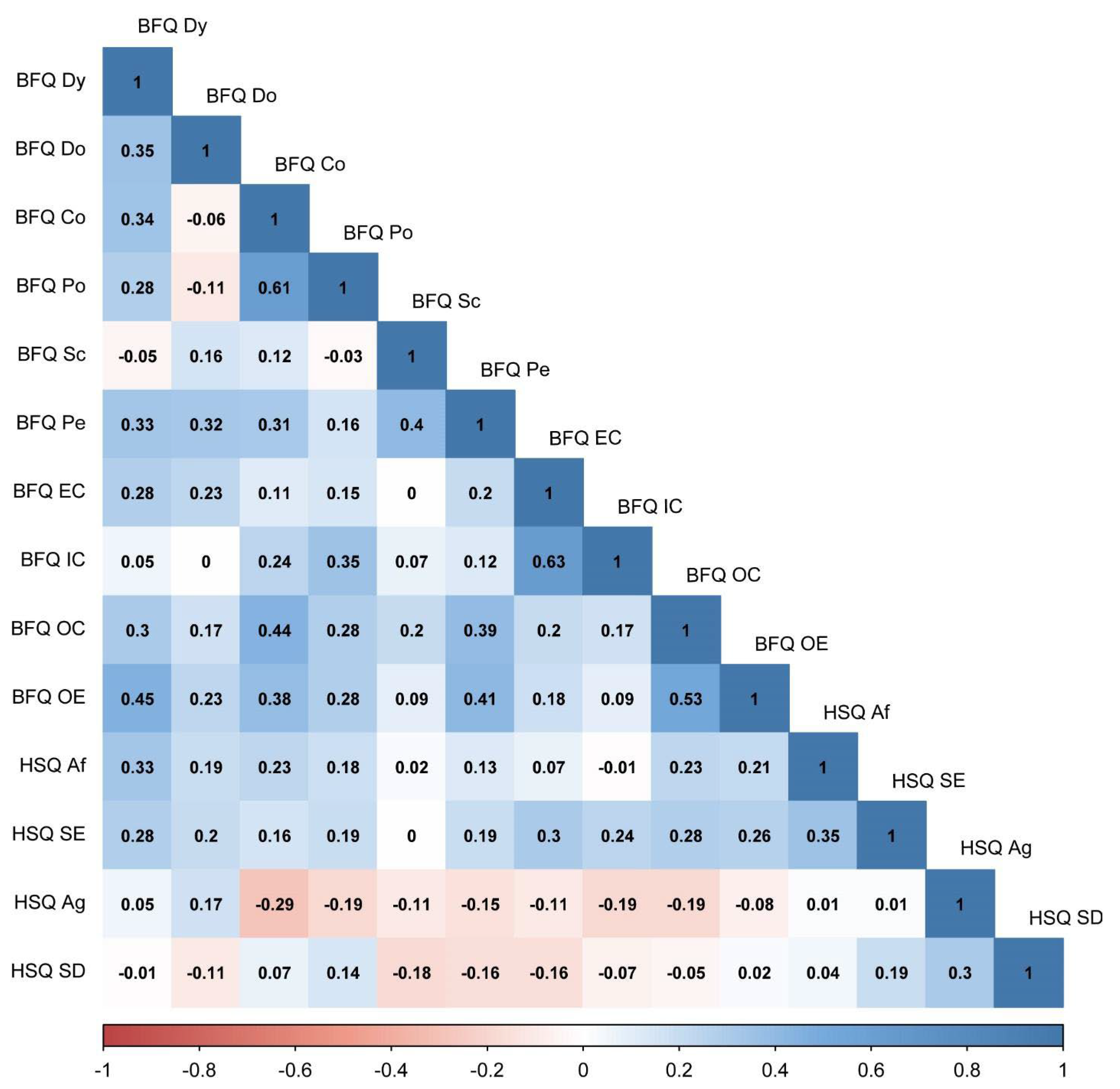
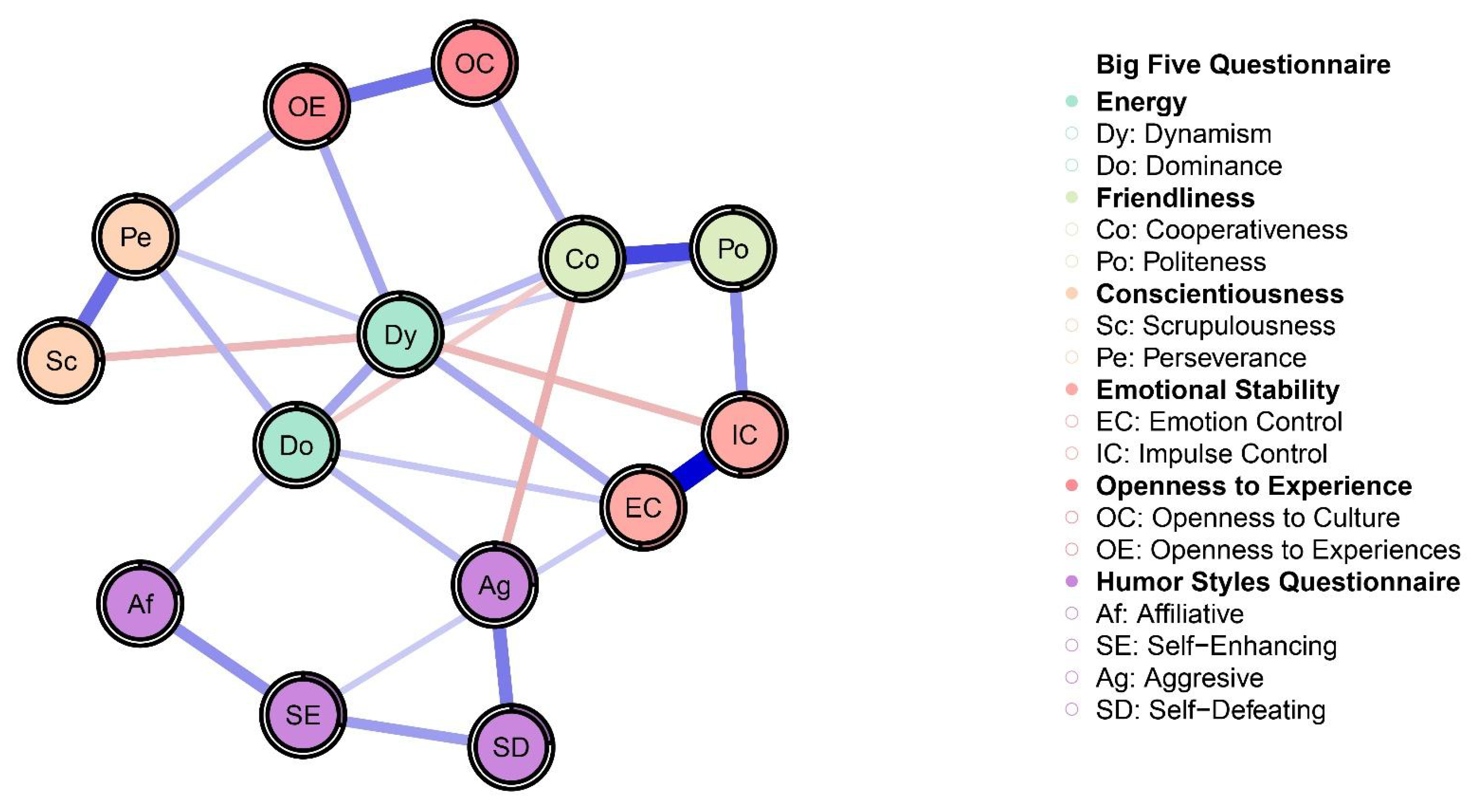

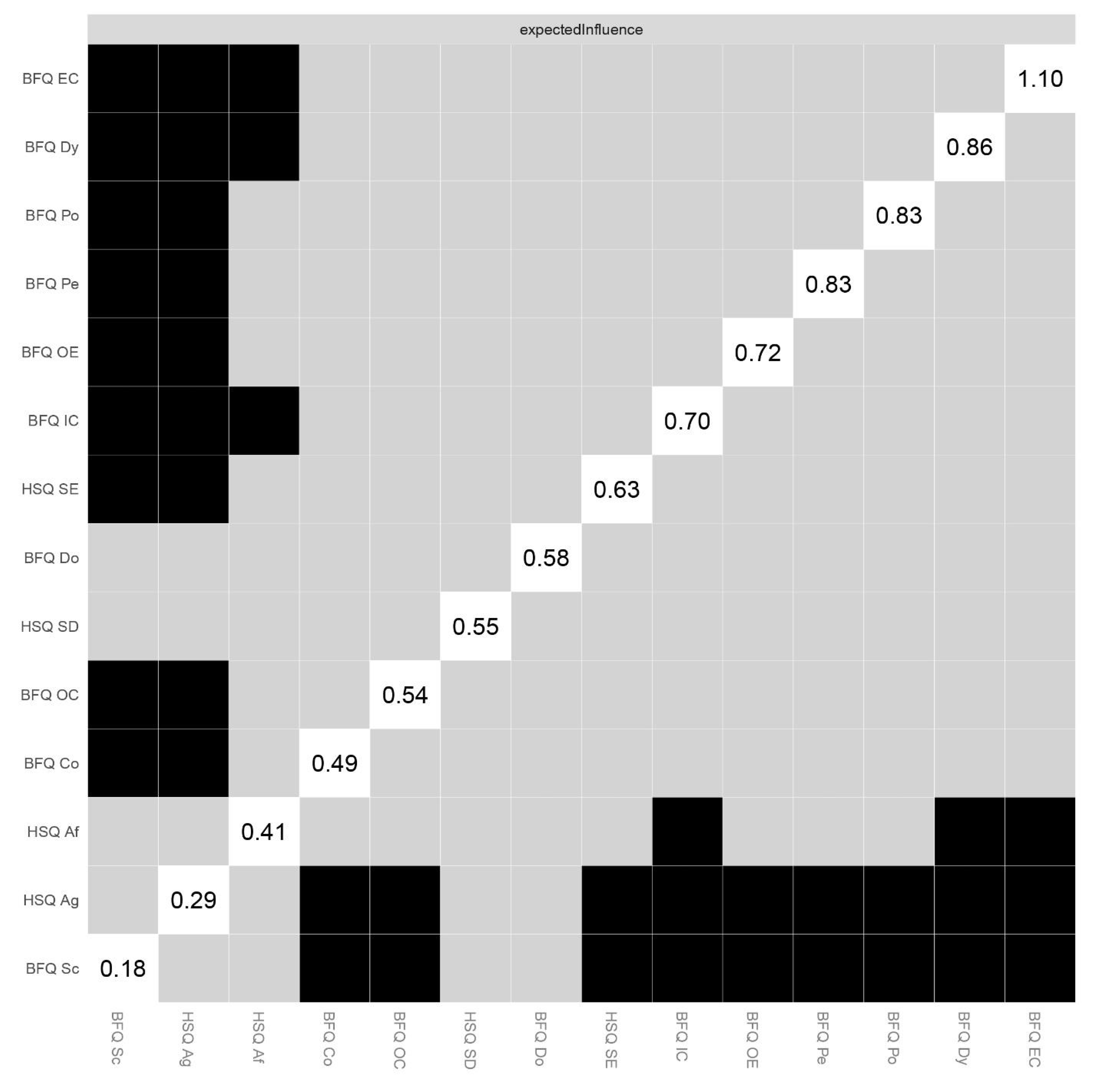
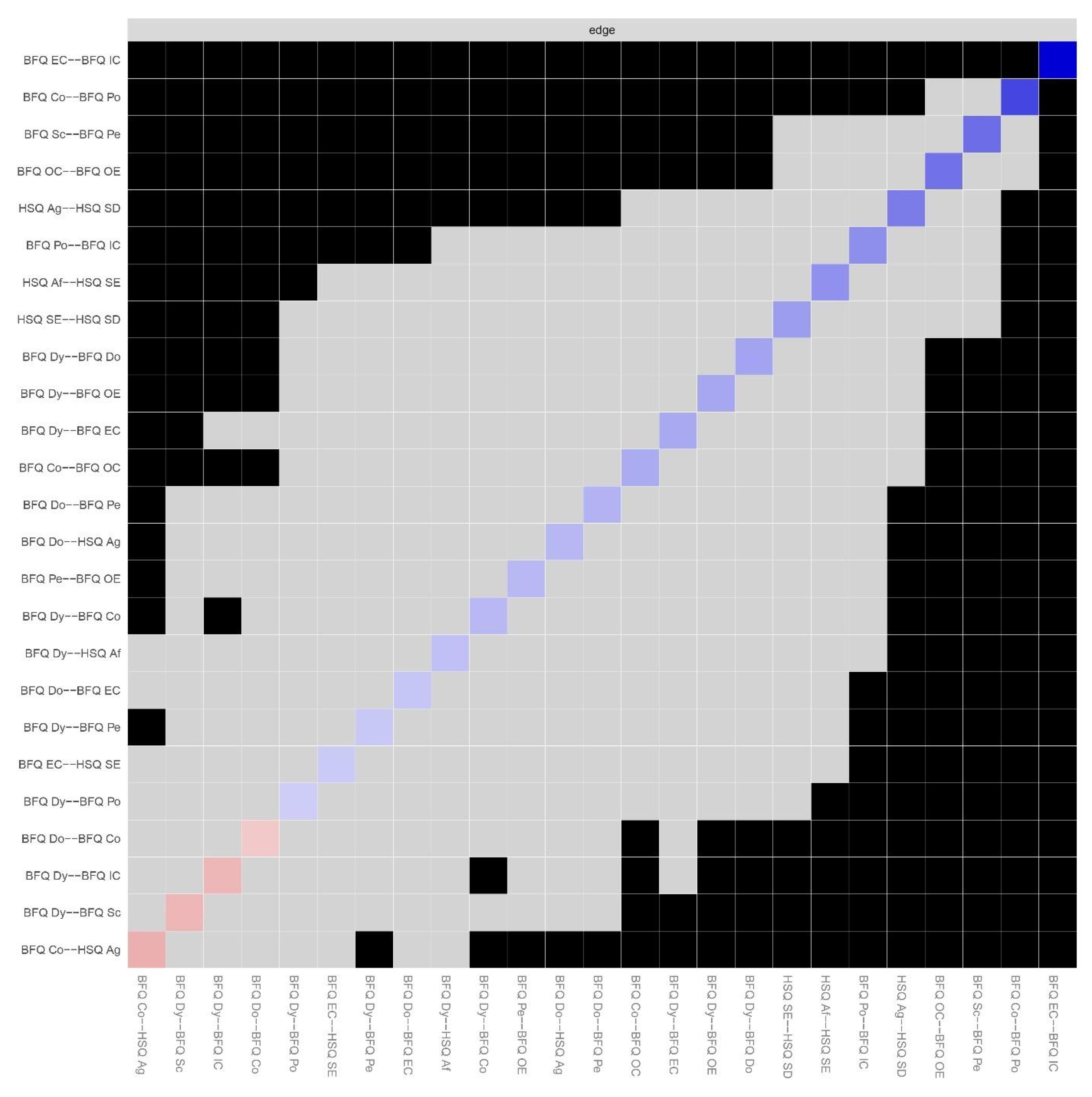
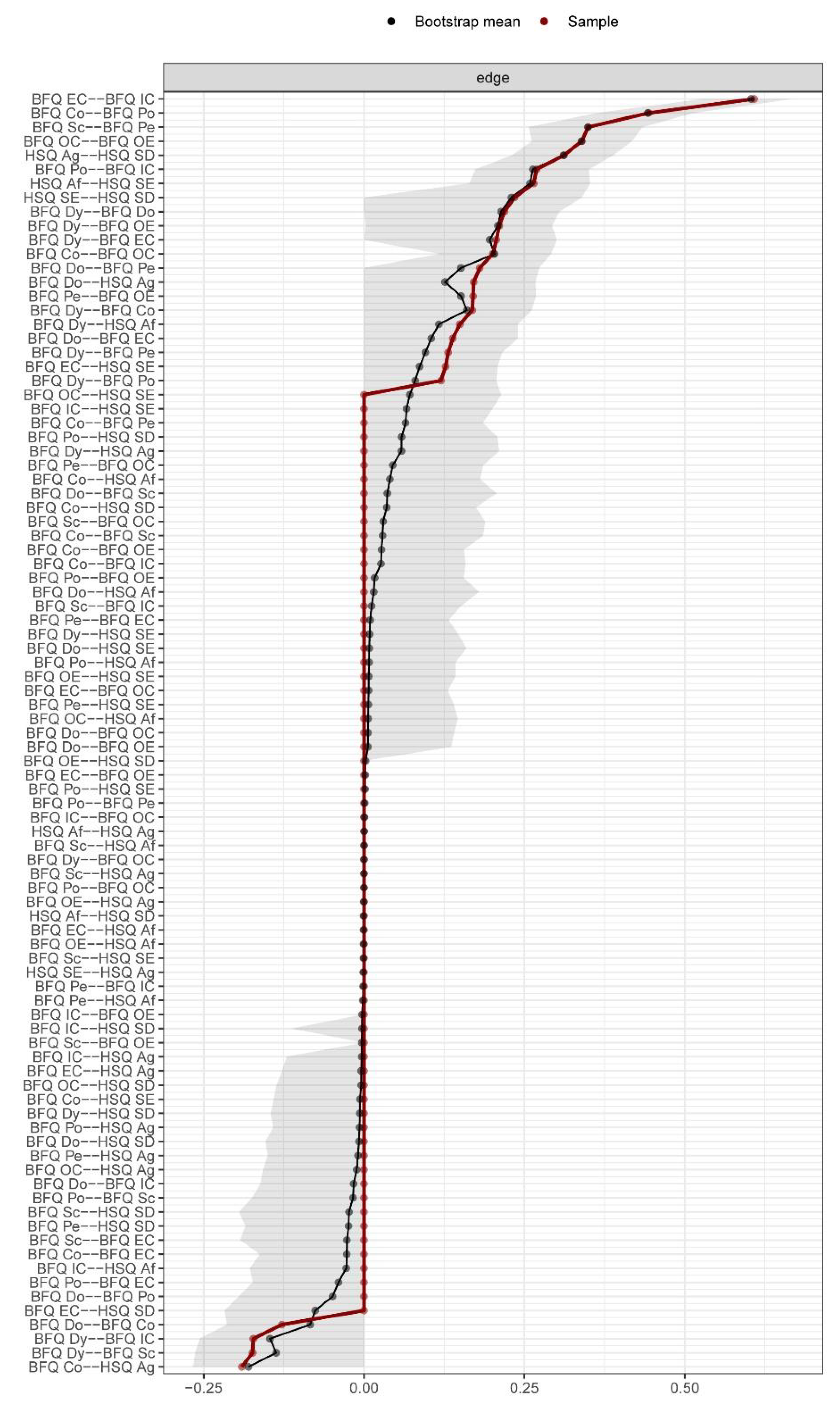
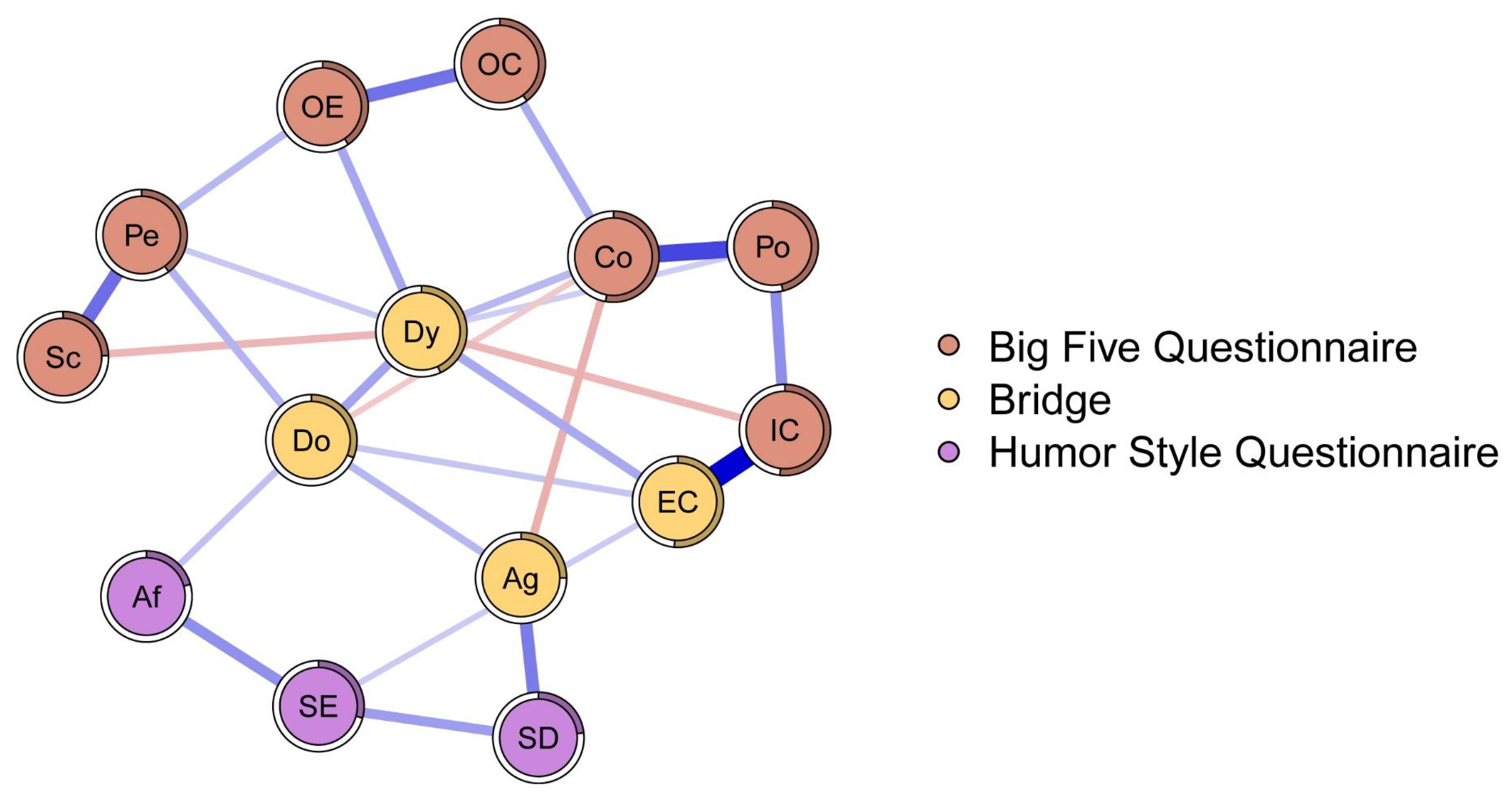
| Study Variables | M | SD | Min | Max | Sk. | Kr. | α | ω |
|---|---|---|---|---|---|---|---|---|
| BFQ Dynamism | 40.49 | 5.19 | 24 | 54 | 0.05 | 0.25 | 0.74 | 0.76 |
| BFQ Dominance | 34.61 | 5.78 | 17 | 53 | 0.17 | 0.70 | 0.77 | 0.80 |
| BFQ Cooperativeness | 41.98 | 5.46 | 22 | 58 | −0.05 | −0.02 | 0.78 | 0.79 |
| BFQ Politeness | 38.49 | 6.00 | 19 | 60 | −0.16 | 0.37 | 0.77 | 0.81 |
| BFQ Scrupulousness | 40.30 | 6.85 | 16 | 59 | −0.15 | 0.12 | 0.86 | 0.88 |
| BFQ Perseverance | 43.34 | 6.22 | 21 | 60 | −0.24 | 0.45 | 0.88 | 0.91 |
| BFQ Emotion Control | 36.16 | 7.82 | 16 | 59 | −0.05 | −0.19 | 0.93 | 0.94 |
| BFQ Impulse Control | 35.60 | 7.00 | 12 | 58 | −0.26 | 0.61 | 0.89 | 0.90 |
| BFQ Openness to Culture | 41.47 | 5.96 | 18 | 56 | −0.25 | 0.03 | 0.71 | 0.73 |
| BFQ Openness to Experiences | 40.77 | 5.75 | 20 | 55 | 0.08 | −0.17 | 0.86 | 0.87 |
| HSQ Affiliative | 40.43 | 8.43 | 9 | 56 | −0.32 | −0.03 | 0.80 | 0.82 |
| HSQ Self-enhancing | 35.16 | 7.58 | 16 | 56 | 0.10 | −0.18 | 0.70 | 0.71 |
| HSQ Aggressive | 23.04 | 6.74 | 8 | 44 | 0.08 | −0.56 | 0.71 | 0.73 |
| HSQ Self-defeating | 25.69 | 8.43 | 8 | 56 | 0.40 | 0.35 | 0.76 | 0.77 |
Disclaimer/Publisher’s Note: The statements, opinions and data contained in all publications are solely those of the individual author(s) and contributor(s) and not of MDPI and/or the editor(s). MDPI and/or the editor(s) disclaim responsibility for any injury to people or property resulting from any ideas, methods, instructions or products referred to in the content. |
© 2023 by the authors. Licensee MDPI, Basel, Switzerland. This article is an open access article distributed under the terms and conditions of the Creative Commons Attribution (CC BY) license (https://creativecommons.org/licenses/by/4.0/).
Share and Cite
Di Fabio, A.; Gori, A.; Svicher, A. Relationships between Humor Styles and the Big Five Personality Traits in Workers: A Network Analysis. Int. J. Environ. Res. Public Health 2023, 20, 1008. https://doi.org/10.3390/ijerph20021008
Di Fabio A, Gori A, Svicher A. Relationships between Humor Styles and the Big Five Personality Traits in Workers: A Network Analysis. International Journal of Environmental Research and Public Health. 2023; 20(2):1008. https://doi.org/10.3390/ijerph20021008
Chicago/Turabian StyleDi Fabio, Annamaria, Alessio Gori, and Andrea Svicher. 2023. "Relationships between Humor Styles and the Big Five Personality Traits in Workers: A Network Analysis" International Journal of Environmental Research and Public Health 20, no. 2: 1008. https://doi.org/10.3390/ijerph20021008
APA StyleDi Fabio, A., Gori, A., & Svicher, A. (2023). Relationships between Humor Styles and the Big Five Personality Traits in Workers: A Network Analysis. International Journal of Environmental Research and Public Health, 20(2), 1008. https://doi.org/10.3390/ijerph20021008









